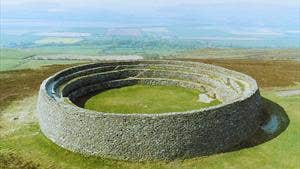The Stone Fort of Grianán of Aileach sits on a hilltop in Inishowen County Donegal. 250m above sea level, the stone fort was probably first built on an earthen rath.
The view from Aileach is breathtaking. The glistening waters of Lough Foyle and Lough Swilly are clear, as is the form of the entire peninsula. A windy and exposed place, Grianán has been a silent witness to the history of Ireland.
The origins of the Grianán of Aileach fort are dated back to 1700 BC. It is linked to the Tuatha de Danann who invaded Ireland before the Celts and built stone forts on top of strategic hills. They worshipped Dagda (the Good God) and he too is associated with the origins of Aileach. It was he who ordered the building of a stone fort to act as a burial monument to his dead son.
The round fort is built largely without mortar. The interior has three terraces and wooden structures were built against the terraces to provide accommodation. The outline of Bronze Age or Iron Age ramparts can be seen below the fort. Legend states that the giants of Inishowen are lying sleeping but when the sacred sword is removed they will spring to life reclaiming their ancient lands.
Mr Walter Bernard of Derry restored the stone fort or cashel in the 1870s. It is the centrepiece of the site, 23m in internal diameter with walls measuring 5m in height and approximately 4m in thickness. The dry stone walls contain two passages within them as well as terraces along their interior which would have allowed access to their summit.
It is thought that St Patrick visited the site in the 5th century and baptised the local chieftain, Eoghan (from whom Inis Eoghan gets its name), here.
